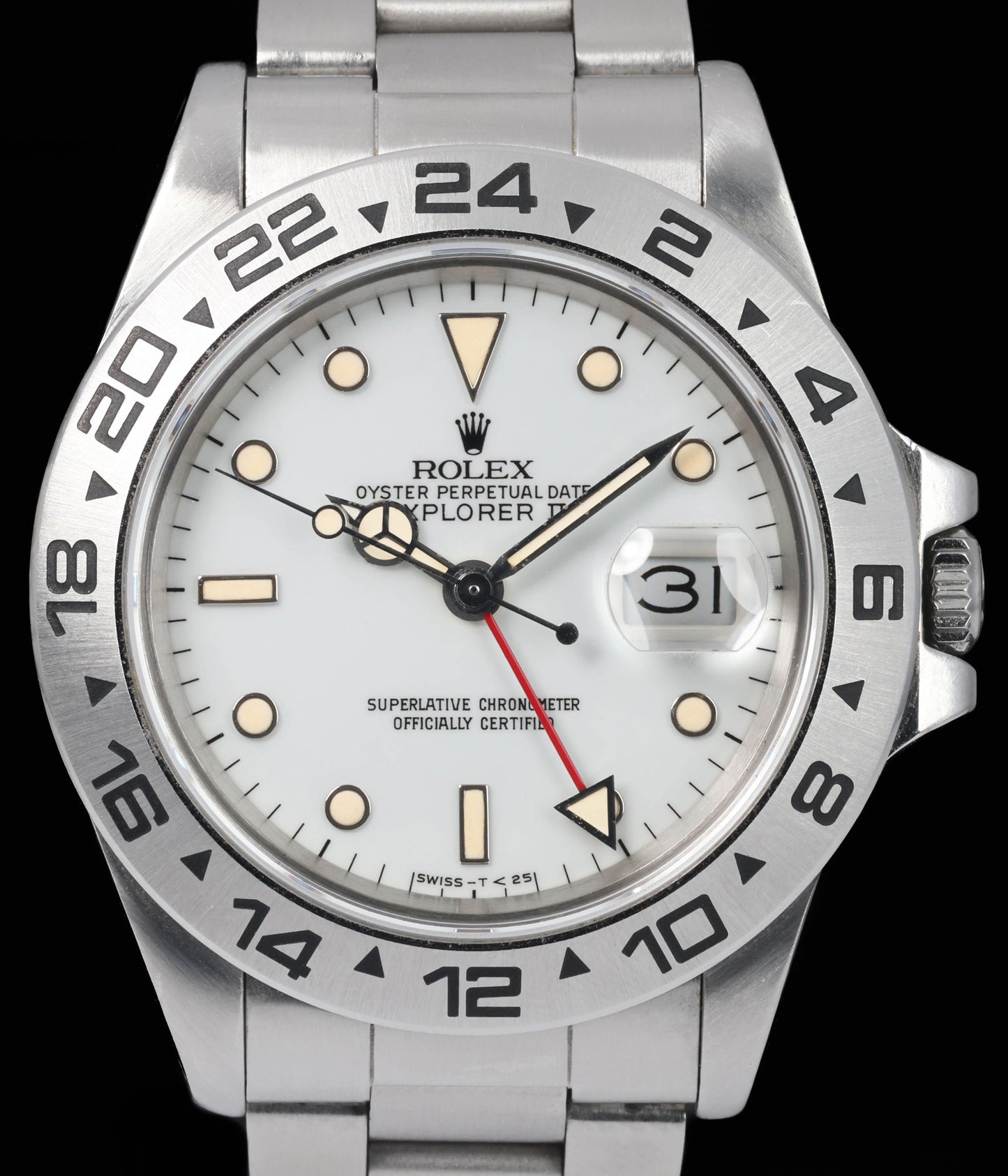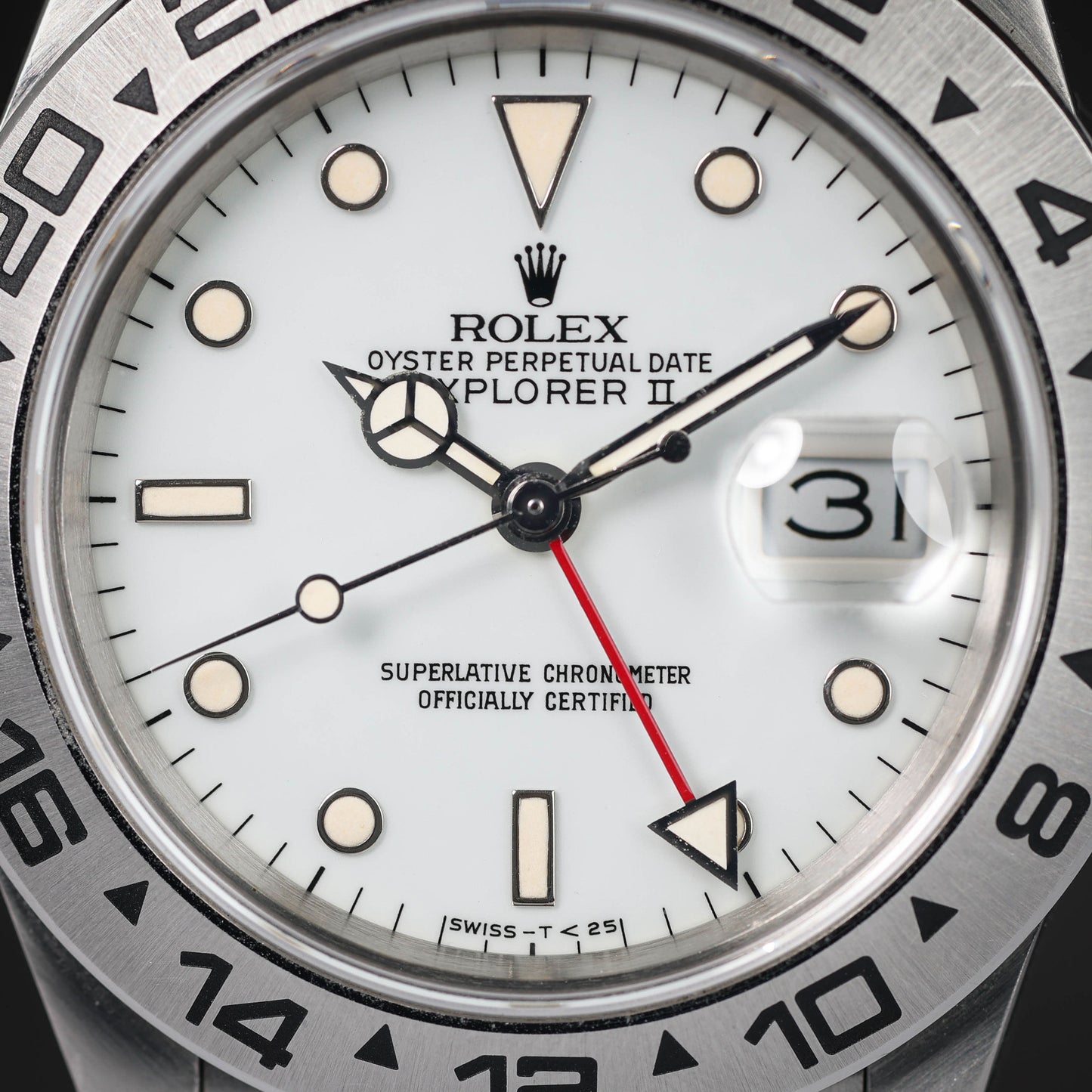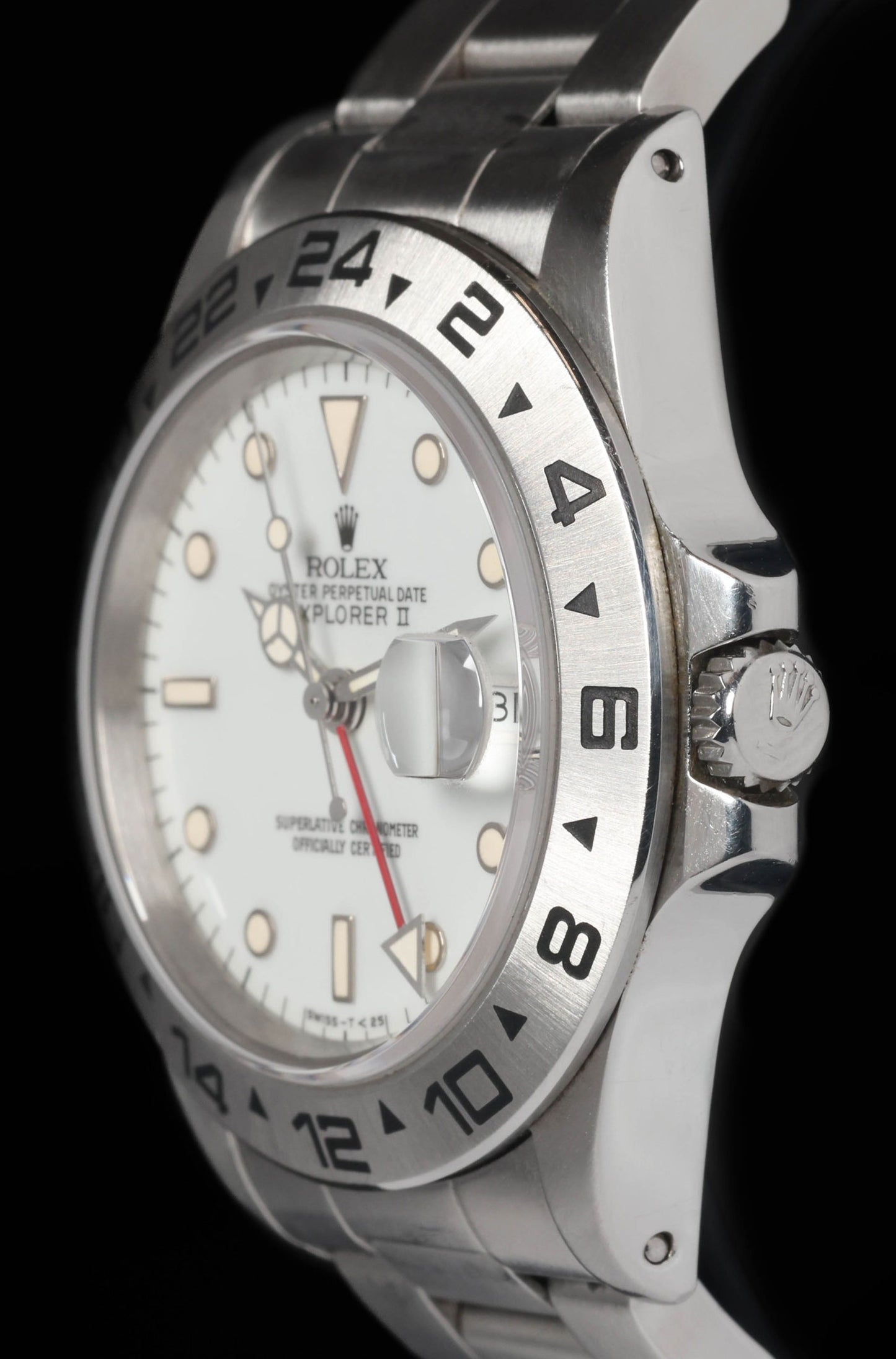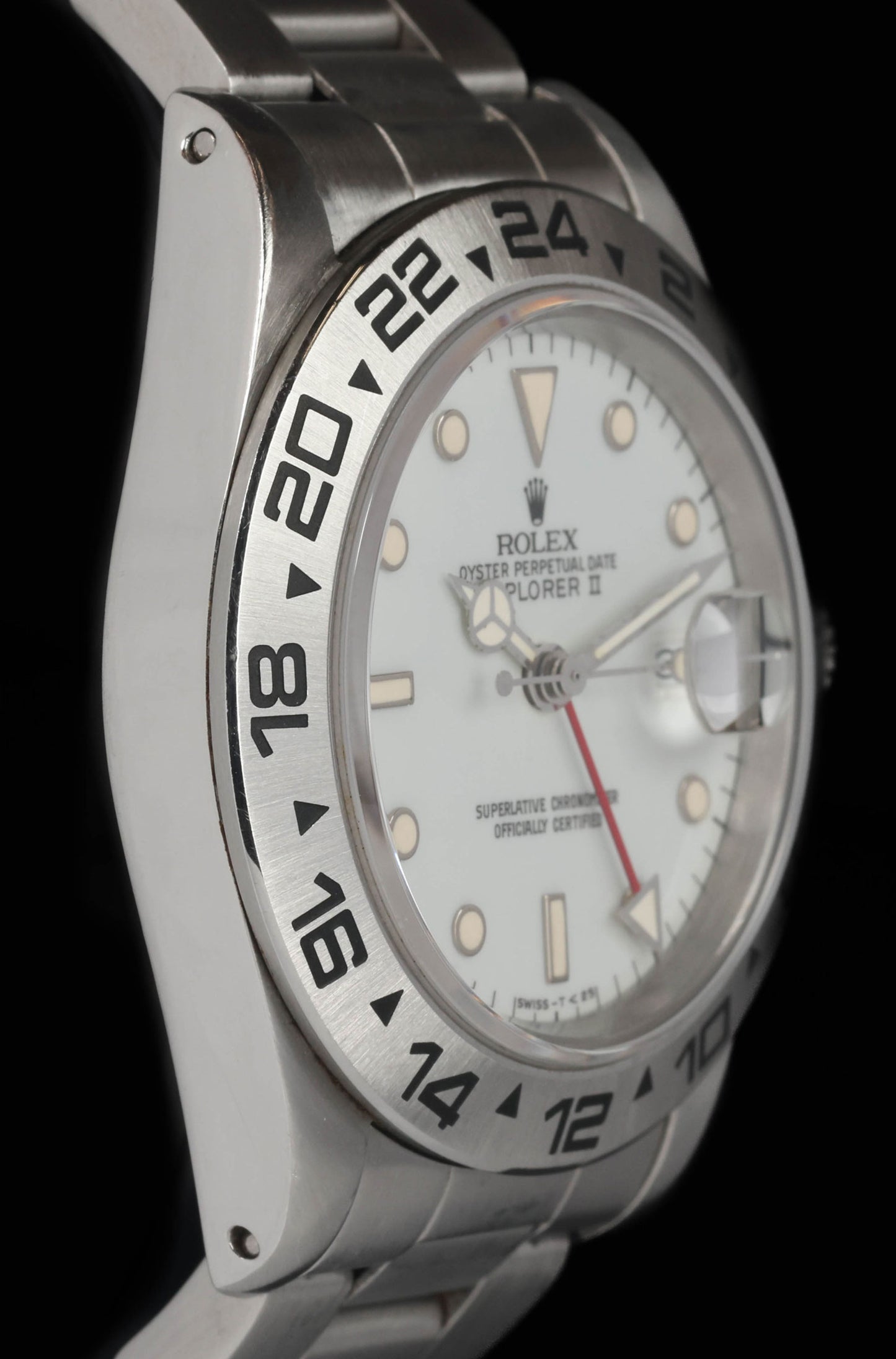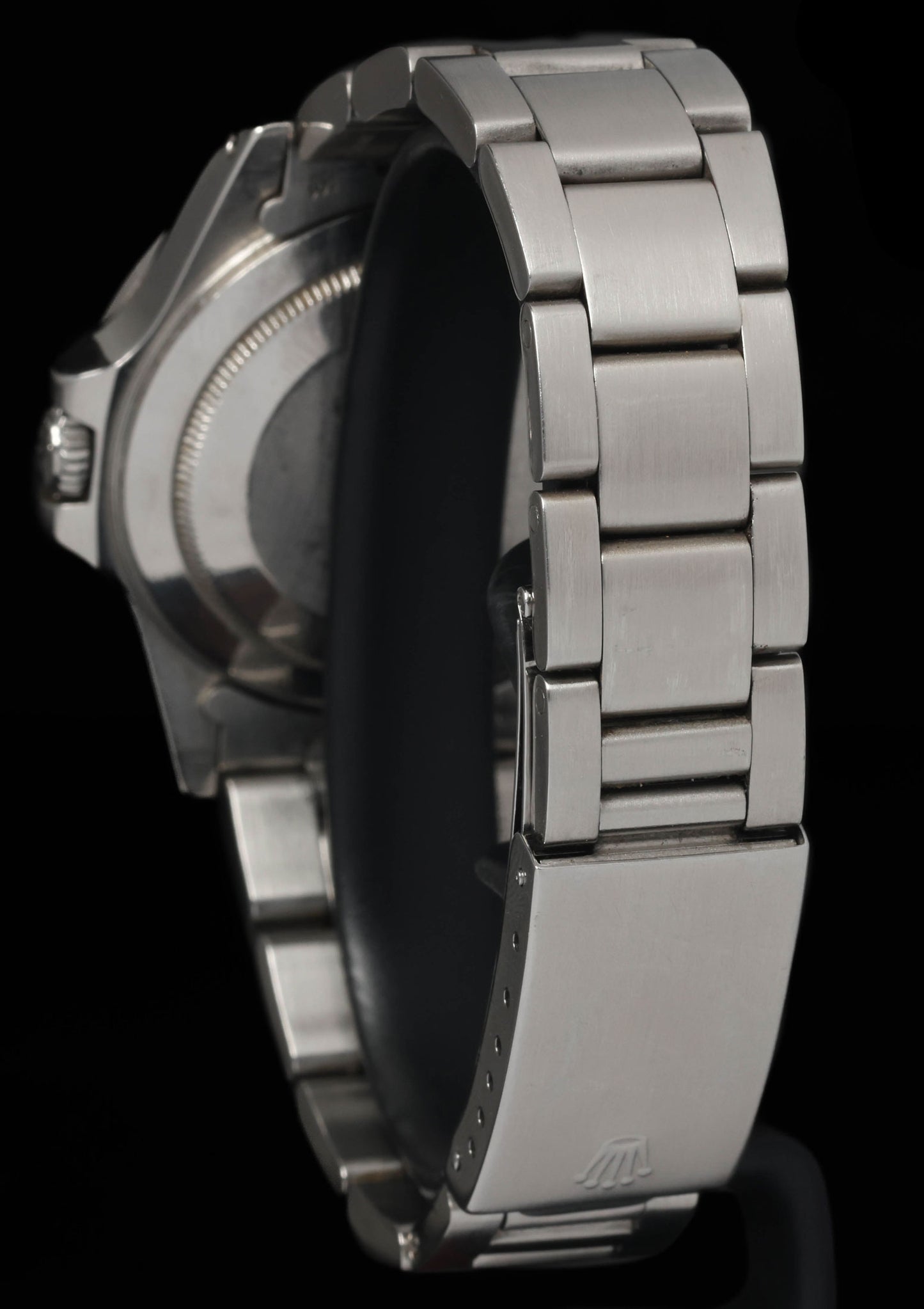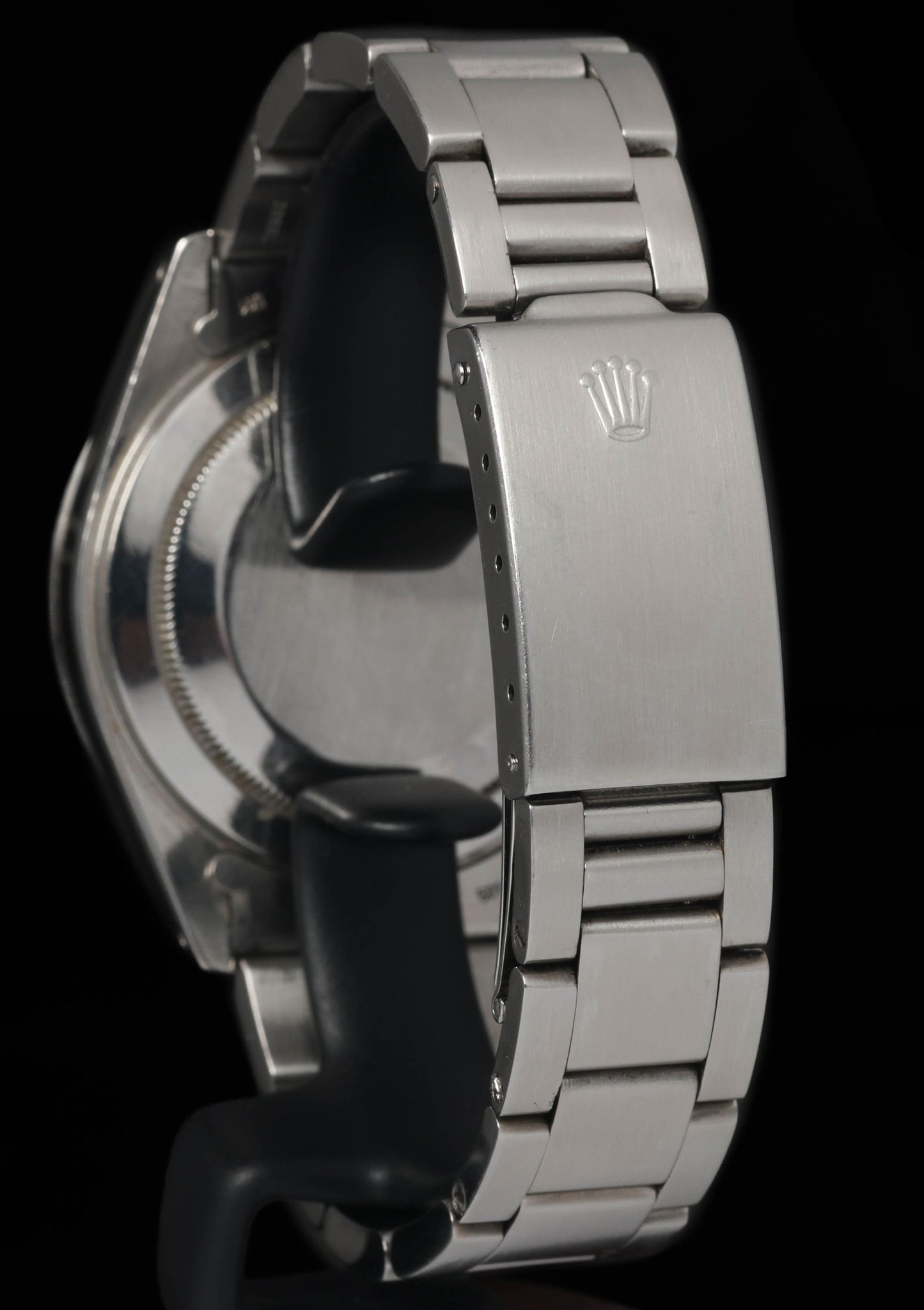Crown Vintage
Rolex Explorer II Polar 16550 'Rail Dial' 40MM 1987
Rolex Explorer II Polar 16550 'Rail Dial' 40MM 1987
Couldn't load pickup availability
Rolex Explorer II Polar 16550 'Rail Dial' 40MM 1987
The stainless steel case remains in great vintage condition, displaying only light hairlines around the sides consistent with careful wear over time. The edges retain good definition and the case has not been subject to heavy polishing, preserving its original profile.
The standout Polar dial is in excellent condition, having developed an attractive and even cream patina across the hour markers that adds depth and warmth to the watch’s overall character. The rare ‘Rail Dial’ printing is sharp and intact.
The Mercedes hands are also in great condition, showing light oxidation that harmonises with the creamy patina of the lume, creating a cohesive vintage aesthetic.
Overall, this is a well-preserved example of the transitional Explorer II reference 16550, combining its distinctive dial layout with the highly desirable cream-toned patina. As this piece is now over 30 years old, it should be treated as a vintage timepiece and not worn while swimming, even though the model was originally designed as a tool watch.
Share
Why we love this watch
Why we love this watch
Rolex Explorer II 16550 with a Rail Dial
Introduction
The Rolex Explorer II reference 16550 occupies a transitional and often misunderstood place in the history of the Explorer line. Produced for only a few short years in the mid-1980s, it marked the shift from the original Explorer II 1655 to a more modern aesthetic that would carry forward into later models. While the 16550 was officially introduced as a successor, it ended up being something of an interim reference due to rapid technical and stylistic changes at Rolex during that period.
Among its dial variations, the “rail dial” stands out as both rare and historically significant. It is defined by the alignment of the text “Superlative Chronometer Officially Certified,” where the spacing forms two parallel vertical lines down the centre of the dial—hence the term “rail.” This layout, paired with the white or black dial configurations of the 16550, makes for one of the most fascinating sub-variants in the Explorer II lineage.
To understand the rail dial fully, it is essential to explore the broader history of the Explorer II, the technical evolution of the 16550, and the factors that led to the dial’s short-lived but enduring presence in Rolex’s catalogue.
Origins of the Explorer II Line
The Rolex Explorer II was first introduced in 1971 with the reference 1655. While the original Explorer of the 1950s was designed with mountaineers and adventurers in mind, the Explorer II was conceived as a tool for spelunkers, cave explorers, and others who operated in environments where distinguishing between day and night was essential.
The 1655 featured a fixed 24-hour bezel and an orange 24-hour hand, which allowed the wearer to keep track of AM and PM hours. Its dial was busy, with a distinctive array of luminous markers and bold hands. Nicknamed the “Freccione” for its large orange hand, the 1655 was unlike any other Rolex of its era.
By the mid-1980s, however, Rolex was updating many of its professional models to reflect new tastes and technological advancements. The Submariner, GMT-Master, and Explorer II were all being modernised with sapphire crystals, new calibres, and design refinements. It was in this context that the Explorer II 16550 was born.
The Reference 16550: A Transitional Model
Launched around 1985, the 16550 replaced the 1655 and represented a dramatic redesign. The case grew to 40mm, aligning it with contemporary Submariners and GMT-Masters. The crystal was upgraded to scratch-resistant sapphire, giving the watch a sleeker, more modern profile. Most importantly, the watch was powered by the new calibre 3085, which featured an independently adjustable 24-hour hand—a key technical advancement that greatly improved functionality.
With the 16550, Rolex also introduced dial options in either black or white, broadening the Explorer II’s appeal. The white dials in particular would go on to develop unique patinas over time, sometimes turning a rich cream tone—a feature that has become highly prized.
Despite its technical advancements, the 16550 was produced only for a few years before being replaced by the 16570 in 1989. This short production run, combined with dial variations like the rail dial, has ensured the 16550’s lasting reputation as an important transitional reference.
What Defines a Rail Dial?
The rail dial is characterised by the typography of the lower-half text: “Superlative Chronometer Officially Certified.” On rail dials, the words “Superlative” and “Officially” line up on the left margin, while “Chronometer” and “Certified” align on the right margin, forming a pair of parallel vertical lines down the centre of the dial.
This layout is not unique to the Explorer II; it also appeared in some GMT-Master and Sea-Dweller references of the period. However, in the context of the 16550, it adds another layer of rarity to an already short-lived reference.
The rail dial was produced by dial maker Stern, known for its precision printing. Because dial production was divided between suppliers, variations in fonts, spacing, and lume plots emerged. This explains why some 16550s feature rail dials while others do not.
Dial Configurations of the 16550
The 16550 was produced with both black and white dial options. The black dials often exhibited issues with paint stability, leading to examples that faded or developed unusual surface textures. The white dials, meanwhile, sometimes experienced a chemical reaction in the lacquer, causing them to turn creamy or ivory in tone.
Rail dials are found in both black and white variants, though the white rail dials are especially striking due to the contrast between the creamy dial and the sharp text alignment. When combined with the warm patina of tritium lume plots, these dials achieve a vintage character that is unmistakable.
Technical Innovations: The Calibre 3085
At the heart of the 16550 is the Rolex calibre 3085, an automatic movement with a quickset date and an independently adjustable 24-hour hand. This was the first time the Explorer II allowed the wearer to set the 24-hour hand separately from the main time, effectively turning the watch into a dual-time zone instrument.
This movement was also used in the GMT-Master II 16760, known as the “Fat Lady.” Its inclusion in the Explorer II marked a significant leap forward in practicality. For spelunkers or adventurers, the ability to track both standard time and a reference time (such as home time or GMT) greatly expanded the watch’s functionality.
The calibre 3085 was produced only for a few years before being replaced by the calibre 3185 in later references, adding another layer of historical significance to the 16550.
Case and Bezel Design
The case of the 16550 measures 40mm, with crown guards flanking the Triplock crown. The bezel is fixed and engraved with 24-hour markers, maintaining the Explorer II’s identity as distinct from the rotating bezels of the GMT-Master.
The bezel font of the 16550 differs slightly from later references, with thinner numerals that give the watch a more delicate appearance. Over time, bezels on well-worn examples often developed scratches and fading, adding to the vintage character.
Bracelet and Reference Details
The 16550 was delivered on the Oyster bracelet, typically with reference 78360 and 580 end links. The bracelet integrated seamlessly with the case, giving the watch a solid, tool-like presence. As with other Rolex models of the era, the bracelet featured hollow centre links and a stamped clasp, reflecting the construction standards of the mid-1980s.
The Short Production Run
The 16550’s production lasted only about four years, from 1985 to 1989. Several factors contributed to its short life. Issues with dial stability—especially with the white dials turning cream—likely influenced Rolex’s decision to replace it with the 16570. Additionally, the 3085 calibre was relatively quickly succeeded by the 3185, reflecting Rolex’s push toward incremental improvements.
This brevity means that rail dial variants of the 16550 are especially rare, as they were produced in limited numbers within an already narrow production window.
Historical Significance of the Rail Dial 16550
The rail dial 16550 is important for several reasons. It represents a rare intersection of transitional technology, unique dial typography, and limited production. While the 16550 as a whole served as a bridge between the quirky 1655 and the long-lived 16570, the rail dial variant captures a fleeting design detail that reflects Rolex’s production practices of the 1980s.
Furthermore, the rail dial embodies the nuances that define vintage Rolex scholarship today. Subtle variations in dial printing, once overlooked, are now recognised as markers of authenticity and historical context. The rail dial is thus not only a visually distinctive configuration but also a piece of evidence in the broader story of Rolex’s evolving manufacturing partnerships.
The Explorer II’s Evolution After the 16550
When the 16570 was introduced in 1989, it retained the overall design of the 16550 but addressed many of its shortcomings. The new calibre 3185 offered improved performance, and the dials were stabilised to prevent the colour changes that had characterised earlier models.
The 16570 would go on to be produced for over two decades, cementing the Explorer II’s place in Rolex’s professional line-up. Yet without the transitional 16550, with its innovations and experiments, the 16570 might never have reached the maturity it displayed.
Wearing the 16550 Rail Dial Today
On the wrist, the 16550 rail dial strikes a balance between vintage charm and modern utility. The 40mm case feels contemporary, while the slim bezel and tritium dial details remind the wearer of its mid-1980s origin. The rail text alignment is subtle but rewarding to those who know what to look for.
The creamy tones of aged white dials, or the characterful wear on black dials, provide a warmth that modern equivalents lack. Combined with the independent 24-hour hand, the watch remains practical for modern travel and adventure, making it more than just a historical curiosity.
Final Thoughts
The Rolex Explorer II 16550 with a rail dial represents a brief but fascinating moment in the brand’s history. Introduced as a modern successor to the 1655, the 16550 brought sapphire crystals, larger cases, and the calibre 3085’s dual-time capability to the Explorer II line. Yet it was produced for such a short time that its many variations—particularly the rail dial—have become markers of a transitional era at Rolex.
The rail dial’s distinctive text alignment, combined with the quirks of dial chemistry and the calibre 3085, ensures that the 16550 stands apart in the Explorer family. More than just a tool watch, it is a reminder of how Rolex evolved in the 1980s, refining its professional models while leaving behind details that today serve as windows into that history.
Case & Bracelet
Case & Bracelet
Case in great vintage condition, light hairlines visible around case consistent with careful wear.
Dial & Hands
Dial & Hands
- Dial & hands in great condition.
- Dial has formed even cream patina.
- Hands lightly oxidised with cream patina.
Warranty & Condition
Warranty & Condition
Crown Vintage Watches provides a minimum 3-month mechanical warranty on pre-owned watches, from the date of purchase.
The warranty covers mechanical defects only.
The warranty does not cover damages such as scratches, finish, crystals, glass, straps (leather, fabric or rubber damage due to wear and tear), damage resulting from wear under conditions exceeding the watch manufacturer’s water resistance limitations, and damage due to physical and or accidental abuse.
Please note, water resistance is neither tested nor guaranteed.
Shipping and insurance costs for warranty returns to us must be covered by the customer. Returns must be shipped via traceable courier. Return shipment must be pre-paid and fully insured. Collect shipping will be refused. In case of loss or damages, the customer is liable.
Our Pledge
At Crown Vintage Watches, we stand by the authenticity of every product we sell. For added peace of mind, customers are welcome to have items independently authenticated at their own expense.
Condition
Due to the nature of vintage timepieces, all watches are sold as is. We will accurately describe the current condition and working order of all watches we sell to the best of our ability.
Shipping & Refund
Shipping & Refund
